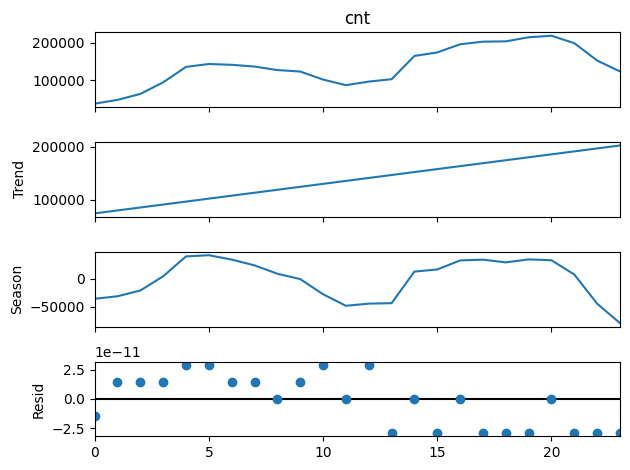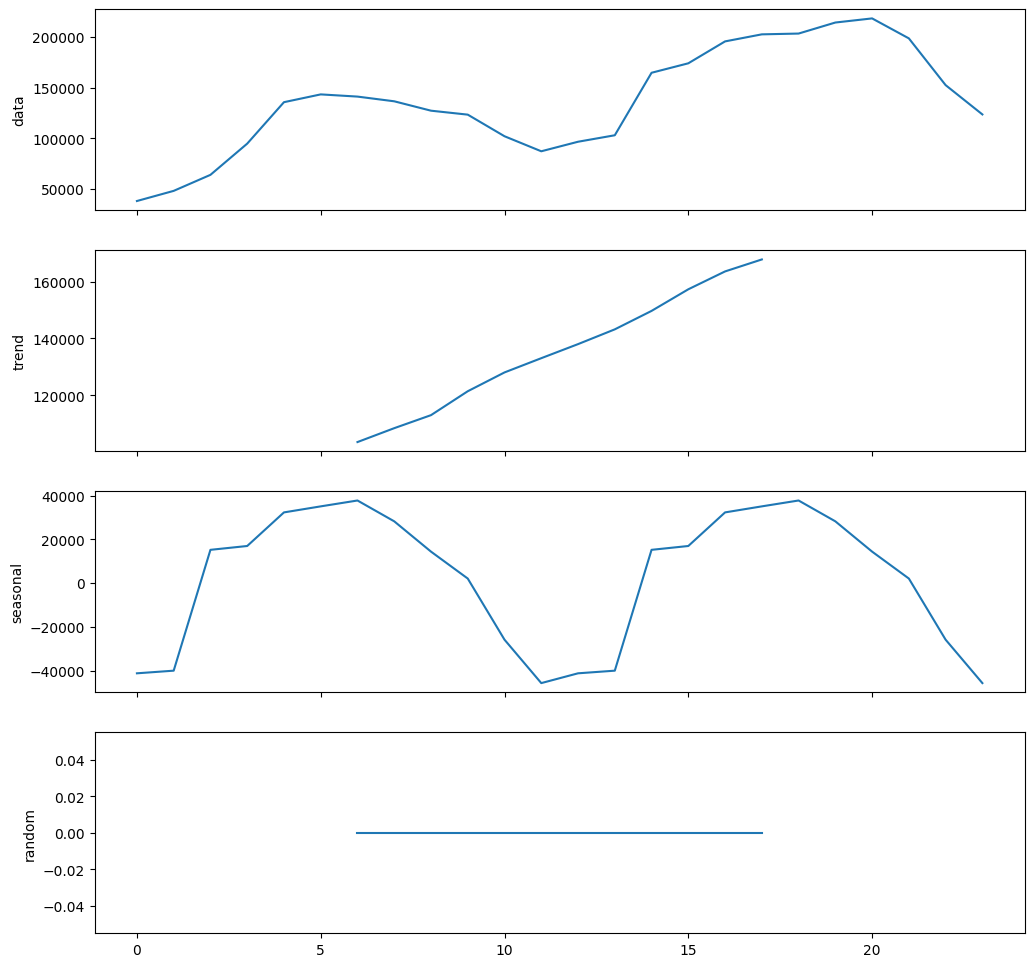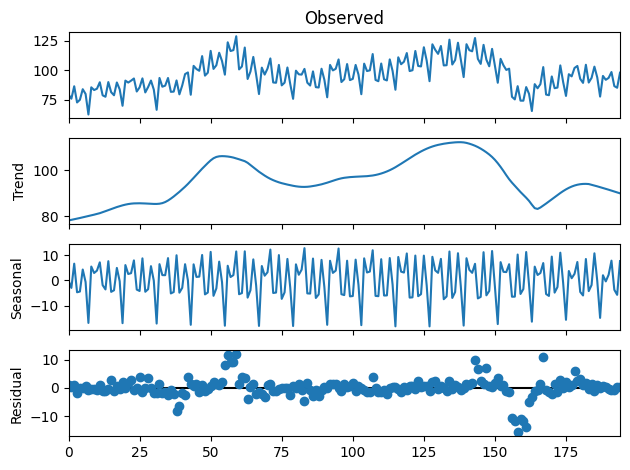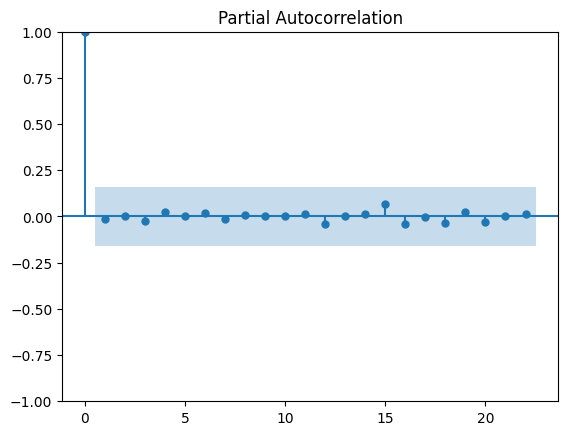Examples of time-series forecasting with Python#
Building on the excellent (and freely available!) Forecasting: Principles and Practice (3rd edition) by Hyndman and Athanasopoulos, this notebooks presents a number of examples using the following Python libraries:
statsmodels.tsaas the basis for time-series analysispmdarimawhich wrapsstatsmodelsinto a convenientauto.arimafunction like in RTO DO:
sktimeas the new, unified framework for machine learning in Python
Use Altair for plotting, as an example how to use this library throughout your workflow
import altair as alt
import numpy as np
import pandas as pd
import rdata
import requests
# https://altair-viz.github.io/user_guide/faq.html#local-filesystem
# alt.data_transformers.enable("json")
def read_rda(url):
"""Reads .rda file from URL and returns dict with values.
"""
r = requests.get(url)
parsed = rdata.parser.parse_data(r.content)
return rdata.conversion.convert(parsed)
EDA with an interactive dashboard#
Bike sharing dataset#
As an example, we will explore the bike sharing dataset, taken from the UCI Machine Learning Repository
Data Set Information#
Bike sharing systems are new generation of traditional bike rentals where whole process from membership, rental and return back has become automatic. Through these systems, user is able to easily rent a bike from a particular position and return back at another position. Currently, there are about over 500 bike-sharing programs around the world which is composed of over 500 thousands bicycles. Today, there exists great interest in these systems due to their important role in traffic, environmental and health issues.
Apart from interesting real world applications of bike sharing systems, the characteristics of data being generated by these systems make them attractive for the research. Opposed to other transport services such as bus or subway, the duration of travel, departure and arrival position is explicitly recorded in these systems. This feature turns bike sharing system into a virtual sensor network that can be used for sensing mobility in the city. Hence, it is expected that most of important events in the city could be detected via monitoring these data.
Attribute Information#
Both hour.csv and day.csv have the following fields, except hr which is not available in day.csv
instant: record index
dteday : date
season : season (1:winter, 2:spring, 3:summer, 4:fall)
yr : year (0: 2011, 1:2012)
mnth : month ( 1 to 12)
hr : hour (0 to 23)
holiday : weather day is holiday or not (extracted from [Web Link])
weekday : day of the week
workingday : if day is neither weekend nor holiday is 1, otherwise is 0.
weathersit :
1: Clear, Few clouds, Partly cloudy, Partly cloudy
2: Mist + Cloudy, Mist + Broken clouds, Mist + Few clouds, Mist
3: Light Snow, Light Rain + Thunderstorm + Scattered clouds, Light Rain + Scattered clouds
4: Heavy Rain + Ice Pallets + Thunderstorm + Mist, Snow + Fog
temp : Normalized temperature in Celsius. The values are derived via (t-t_min)/(t_max-t_min), t_min=-8, t_max=+39 (only in hourly scale)
atemp: Normalized feeling temperature in Celsius. The values are derived via (t-t_min)/(t_max-t_min), t_min=-16, t_max=+50 (only in hourly scale)
hum: Normalized humidity. The values are divided to 100 (max)
windspeed: Normalized wind speed. The values are divided to 67 (max)
casual: count of casual users
registered: count of registered users
cnt: count of total rental bikes including both casual and registered
def parse_date_hour(date, hour):
"""Construct datetime for index of hourly data."""
return pd.to_datetime(" ".join([date, str(hour).zfill(2)]), format="%Y-%m-%d %H")
daily = pd.read_csv("./bike-sharing/bike-sharing-daily-processed.csv", parse_dates=["dteday"]).drop(
columns=["instant", "Unnamed: 0"]
)
hourly = pd.read_csv("./bike-sharing/hour.csv").drop(columns=["instant"])
hourly.index = pd.DatetimeIndex(
hourly.apply(lambda row: parse_date_hour(row.dteday, row.hr), axis=1),
name="timestamp",
)
daily.head()
| dteday | season | yr | mnth | holiday | weekday | workingday | weathersit | temp | atemp | hum | windspeed | casual | registered | cnt | days_since_2011 | |
|---|---|---|---|---|---|---|---|---|---|---|---|---|---|---|---|---|
| 0 | 2011-01-01 | SPRING | 2011 | 1 | NO HOLIDAY | SAT | NO WORKING DAY | MISTY | 8.175849 | 28.363250 | 80.5833 | 10.749882 | 331 | 654 | 985 | 0 |
| 1 | 2011-01-02 | SPRING | 2011 | 1 | NO HOLIDAY | SUN | NO WORKING DAY | MISTY | 9.083466 | 28.027126 | 69.6087 | 16.652113 | 131 | 670 | 801 | 1 |
| 2 | 2011-01-03 | SPRING | 2011 | 1 | NO HOLIDAY | MON | WORKING DAY | GOOD | 1.229108 | 22.439770 | 43.7273 | 16.636703 | 120 | 1229 | 1349 | 2 |
| 3 | 2011-01-04 | SPRING | 2011 | 1 | NO HOLIDAY | TUE | WORKING DAY | GOOD | 1.400000 | 23.212148 | 59.0435 | 10.739832 | 108 | 1454 | 1562 | 3 |
| 4 | 2011-01-05 | SPRING | 2011 | 1 | NO HOLIDAY | WED | WORKING DAY | GOOD | 2.666979 | 23.795180 | 43.6957 | 12.522300 | 82 | 1518 | 1600 | 4 |
brush = alt.selection(type='interval', encodings=['x'])
base = (alt
.Chart(daily)
.mark_line()
.encode(x='dteday', y='cnt')
.properties(width=700, height=200)
)
overview = base.properties(height=50).add_selection(brush)
detail = base.encode(alt.X('dteday:T', scale=alt.Scale(domain=brush)))
/opt/hostedtoolcache/Python/3.8.18/x64/lib/python3.8/site-packages/altair/utils/deprecation.py:65: AltairDeprecationWarning: 'selection' is deprecated.
Use 'selection_point()' or 'selection_interval()' instead; these functions also include more helpful docstrings.
warnings.warn(message, AltairDeprecationWarning, stacklevel=1)
/opt/hostedtoolcache/Python/3.8.18/x64/lib/python3.8/site-packages/altair/utils/deprecation.py:65: AltairDeprecationWarning: 'add_selection' is deprecated. Use 'add_params' instead.
warnings.warn(message, AltairDeprecationWarning, stacklevel=1)
detail & overview
monthly = daily.groupby(['yr', 'mnth'], as_index=False)['cnt'].sum('cnt')
monthly['yr_mnth'] = monthly.apply(lambda df: '-'.join([str(df.yr), str(df.mnth).zfill(2)]), axis=1)
def simple_ts_plot(df, x='yr_mnth', y='cnt', width=700, height=200):
return alt.Chart(df).mark_line().encode(x=x, y=y).properties(width=width)
simple_ts_plot(monthly)
Decomposition#
Simple decomposition (statsmodels)#
from statsmodels.tsa.seasonal import seasonal_decompose, STL
simple_decomposition = seasonal_decompose(monthly.cnt, period=12)
simple_decomposition.plot();

STL decomposition (statsmodels)#
stl = STL(monthly.cnt, period=12).fit()
stl.plot();

Let’s make those plots better looking with Altair.
_ts = {}
for result in ['observed', 'trend', 'seasonal', 'resid']:
df = pd.DataFrame({'yr_mnth': monthly.yr_mnth, result: getattr(stl, result)})
_ts[result] = simple_ts_plot(df, x='yr_mnth', y=result, height=50)
alt.vconcat(*_ts.values()).resolve_scale(x='shared')
Seasonal decomposition (pmdarima)#
Same result as statsmodels seasonal_decompose.
from pmdarima import arima, utils
# note pmdarima expects nd.array as input
arima_decomp = arima.decompose(monthly.cnt.values, type_='additive', m=12)
utils.decomposed_plot(arima_decomp, figure_kwargs={'figsize': (12,12)})

Forecasting with ETS#
We will reproduce the analysis from FPP2 section 7.7 in Python. following the example from the statsmodels documentation.
Get data: international visitor nights in Australia#
# read data and set proper DateRangeIndex in pandas
austourists_url = "https://github.com/robjhyndman/fpp2-package/blob/master/data/austourists.rda?raw=true"
austourists_data = read_rda(austourists_url)
austourists = pd.DataFrame(austourists_data).set_index(
pd.period_range(start="1999Q1", end="2015Q4", freq="Q")
)
austourists.head()
| austourists | |
|---|---|
| 1999Q1 | 30.052513 |
| 1999Q2 | 19.148496 |
| 1999Q3 | 25.317692 |
| 1999Q4 | 27.591437 |
| 2000Q1 | 32.076456 |
Forecast ETS(M, A, M) model#
Note: use exponential_smoothing.ETSModel and notholtwinters.ExponentialSmoothing
from statsmodels.tsa.exponential_smoothing.ets import ETSModel
aust_ets = ETSModel(
austourists.austourists.rename('observed'), # NB: only take 1D array or pd.Series
error="mul",
trend="add",
seasonal="mul",
damped_trend=True,
seasonal_periods=4
).fit(maxiter=10000)
print(aust_ets.summary())
RUNNING THE L-BFGS-B CODE
* * *
Machine precision = 2.220D-16
N = 9 M = 10
At X0 1 variables are exactly at the bounds
At iterate 0 f= 3.47328D+00 |proj g|= 1.98628D+00
At iterate 1 f= 3.14211D+00 |proj g|= 2.46124D+00
At iterate 2 f= 2.58862D+00 |proj g|= 5.91331D-01
At iterate 3 f= 2.46717D+00 |proj g|= 4.83241D-01
At iterate 4 f= 2.43892D+00 |proj g|= 6.51827D-01
At iterate 5 f= 2.37965D+00 |proj g|= 3.91487D-01
At iterate 6 f= 2.34624D+00 |proj g|= 3.02613D-01
At iterate 7 f= 2.32328D+00 |proj g|= 3.61819D-01
At iterate 8 f= 2.30622D+00 |proj g|= 1.60187D-01
At iterate 9 f= 2.29895D+00 |proj g|= 1.69179D-01
At iterate 10 f= 2.28998D+00 |proj g|= 1.79909D-01
At iterate 11 f= 2.28880D+00 |proj g|= 3.09700D-01
At iterate 12 f= 2.28586D+00 |proj g|= 8.68166D-02
At iterate 13 f= 2.28339D+00 |proj g|= 8.95314D-02
At iterate 14 f= 2.27444D+00 |proj g|= 5.47130D-01
At iterate 15 f= 2.26329D+00 |proj g|= 8.34884D-01
At iterate 16 f= 2.26104D+00 |proj g|= 7.65831D-01
At iterate 17 f= 2.26051D+00 |proj g|= 7.37692D-01
At iterate 18 f= 2.26014D+00 |proj g|= 7.18019D-01
At iterate 19 f= 2.26008D+00 |proj g|= 7.08332D-01
At iterate 20 f= 2.26002D+00 |proj g|= 7.12180D-01
At iterate 21 f= 2.25892D+00 |proj g|= 6.75977D-01
At iterate 22 f= 2.25797D+00 |proj g|= 6.86087D-01
At iterate 23 f= 2.24578D+00 |proj g|= 7.31361D-01
At iterate 24 f= 2.23994D+00 |proj g|= 1.05531D+00
At iterate 25 f= 2.23562D+00 |proj g|= 8.89131D-01
At iterate 26 f= 2.23124D+00 |proj g|= 3.80693D-01
At iterate 27 f= 2.22585D+00 |proj g|= 2.96862D-01
At iterate 28 f= 2.22393D+00 |proj g|= 1.78492D-01
At iterate 29 f= 2.22174D+00 |proj g|= 1.19679D-01
At iterate 30 f= 2.22090D+00 |proj g|= 6.99965D-02
At iterate 31 f= 2.21842D+00 |proj g|= 2.06793D-01
At iterate 32 f= 2.21784D+00 |proj g|= 8.13951D-02
At iterate 33 f= 2.21766D+00 |proj g|= 2.72645D-02
At iterate 34 f= 2.21764D+00 |proj g|= 2.22443D-02
At iterate 35 f= 2.21763D+00 |proj g|= 1.71872D-02
At iterate 36 f= 2.21761D+00 |proj g|= 2.69771D-02
At iterate 37 f= 2.21758D+00 |proj g|= 4.95665D-02
At iterate 38 f= 2.21748D+00 |proj g|= 1.07864D-01
At iterate 39 f= 2.21714D+00 |proj g|= 2.26432D-01
At iterate 40 f= 2.21635D+00 |proj g|= 3.94526D-01
At iterate 41 f= 2.21441D+00 |proj g|= 6.34753D-01
At iterate 42 f= 2.21033D+00 |proj g|= 8.81598D-01
At iterate 43 f= 2.20373D+00 |proj g|= 9.25483D-01
At iterate 44 f= 2.19844D+00 |proj g|= 4.46696D-01
At iterate 45 f= 2.19721D+00 |proj g|= 3.77480D-01
At iterate 46 f= 2.19645D+00 |proj g|= 6.05318D-02
At iterate 47 f= 2.19638D+00 |proj g|= 9.81619D-03
At iterate 48 f= 2.19638D+00 |proj g|= 3.46647D-03
At iterate 49 f= 2.19638D+00 |proj g|= 3.79865D-03
At iterate 50 f= 2.19638D+00 |proj g|= 1.17339D-02
At iterate 51 f= 2.19637D+00 |proj g|= 4.86529D-02
At iterate 52 f= 2.19637D+00 |proj g|= 2.13492D-02
At iterate 53 f= 2.19637D+00 |proj g|= 2.81362D-03
At iterate 54 f= 2.19636D+00 |proj g|= 1.18585D-03
At iterate 55 f= 2.19636D+00 |proj g|= 1.30074D-04
At iterate 56 f= 2.19636D+00 |proj g|= 4.66294D-05
* * *
Tit = total number of iterations
Tnf = total number of function evaluations
Tnint = total number of segments explored during Cauchy searches
Skip = number of BFGS updates skipped
Nact = number of active bounds at final generalized Cauchy point
Projg = norm of the final projected gradient
F = final function value
* * *
N Tit Tnf Tnint Skip Nact Projg F
9 56 68 59 0 3 4.663D-05 2.196D+00
F = 2.1963648196307086
CONVERGENCE: REL_REDUCTION_OF_F_<=_FACTR*EPSMCH
ETS Results
==============================================================================
Dep. Variable: observed No. Observations: 68
Model: ETS(MAdM) Log Likelihood -149.353
Date: Sat, 11 Nov 2023 AIC 320.706
Time: 11:46:17 BIC 345.120
Sample: 03-31-1999 HQIC 330.379
- 12-31-2015 Scale 0.003
Covariance Type: approx
======================================================================================
coef std err z P>|z| [0.025 0.975]
--------------------------------------------------------------------------------------
smoothing_level 0.4969 0.112 4.452 0.000 0.278 0.716
smoothing_trend 4.969e-05 0.009 0.005 0.996 -0.018 0.018
smoothing_seasonal 5.031e-05 nan nan nan nan nan
damping_trend 0.9800 0.011 92.307 0.000 0.959 1.001
initial_level 28.9572 952.799 0.030 0.976 -1838.494 1896.408
initial_trend 1.0006 32.926 0.030 0.976 -63.534 65.535
initial_seasonal.0 0.8395 27.622 0.030 0.976 -53.300 54.979
initial_seasonal.1 0.7777 25.588 0.030 0.976 -49.374 50.929
initial_seasonal.2 0.6242 20.539 0.030 0.976 -39.632 40.881
initial_seasonal.3 1.0000 32.904 0.030 0.976 -63.490 65.490
===================================================================================
Ljung-Box (Q): 4.38 Jarque-Bera (JB): 15.41
Prob(Q): 0.82 Prob(JB): 0.00
Heteroskedasticity (H): 0.16 Skew: -0.89
Prob(H) (two-sided): 0.00 Kurtosis: 4.50
===================================================================================
Warnings:
[1] Covariance matrix calculated using numerical (complex-step) differentiation.
aust_forecast = aust_ets.get_prediction(start="2014", end="2020")
_forecast = (
aust_forecast.summary_frame()
.reset_index()
.rename(columns={"index": "quarter"})
.assign(quarter=lambda df: df.quarter.apply(str))
)
_forecast.head()
| quarter | mean | mean_numerical | pi_lower | pi_upper | |
|---|---|---|---|---|---|
| 0 | 2014Q1 | 67.905019 | 68.005701 | 61.157418 | 75.371850 |
| 1 | 2014Q2 | 41.743568 | 41.810152 | 37.031209 | 45.964023 |
| 2 | 2014Q3 | 53.038218 | 53.087422 | 47.111868 | 58.694715 |
| 3 | 2014Q4 | 58.410221 | 58.516103 | 52.269220 | 64.683609 |
| 4 | 2015Q1 | 70.690958 | 70.855760 | 62.741749 | 79.276381 |
Plot forecast results using Altair#
Because we love Altair, let’s do some plots with that. There are some details you need to consider.
First, Altair can’t plot indexes, hence we need to reformat the data
_aust = (
austourists.reset_index()
.assign(quarter=lambda df: df["index"].apply(str))
.drop(columns="index")
)
_aust.head()
| austourists | quarter | |
|---|---|---|
| 0 | 30.052513 | 1999Q1 |
| 1 | 19.148496 | 1999Q2 |
| 2 | 25.317692 | 1999Q3 |
| 3 | 27.591437 | 1999Q4 |
| 4 | 32.076456 | 2000Q1 |
Now we can plot the data.
(
alt.Chart(
austourists.join(aust_ets.fittedvalues.rename("fitted"))
.stack()
.reset_index(name="values")
.rename(columns={"level_0": "quarter", "level_1": "label"})
.assign(quarter=lambda df: df.quarter.apply(str))
)
.mark_line()
.encode(
x=alt.X("quarter:O", axis=alt.Axis(values=_aust.quarter.values[::4])),
y="values:Q",
color="label",
)
.properties(width=800)
)
line = (
alt.Chart(_forecast)
.mark_line()
.encode(
x=alt.X("quarter:O", axis=alt.Axis(values=_forecast.quarter.values[::4])),
y="mean:Q",
)
)
band = line.mark_area(opacity=0.5).encode(x="quarter", y="pi_lower:Q", y2="pi_upper:Q")
_forecast
| quarter | mean | mean_numerical | pi_lower | pi_upper | |
|---|---|---|---|---|---|
| 0 | 2014Q1 | 67.905019 | 68.005701 | 61.157418 | 75.371850 |
| 1 | 2014Q2 | 41.743568 | 41.810152 | 37.031209 | 45.964023 |
| 2 | 2014Q3 | 53.038218 | 53.087422 | 47.111868 | 58.694715 |
| 3 | 2014Q4 | 58.410221 | 58.516103 | 52.269220 | 64.683609 |
| 4 | 2015Q1 | 70.690958 | 70.855760 | 62.741749 | 79.276381 |
| 5 | 2015Q2 | 45.088088 | 45.072703 | 40.102652 | 50.070189 |
| 6 | 2015Q3 | 57.987363 | 57.758803 | 51.208943 | 64.228500 |
| 7 | 2015Q4 | 64.479834 | 64.590966 | 57.749161 | 71.409733 |
| 8 | 2016Q1 | 77.990539 | 77.775062 | 69.181335 | 86.170029 |
| 9 | 2016Q2 | 48.836287 | 48.593699 | 42.980661 | 54.306214 |
| 10 | 2016Q3 | 61.026694 | 60.969122 | 53.178136 | 69.217190 |
| 11 | 2016Q4 | 66.075834 | 65.793079 | 56.347986 | 75.342749 |
| 12 | 2017Q1 | 78.939466 | 78.526000 | 66.963969 | 90.707224 |
| 13 | 2017Q2 | 49.416785 | 49.283671 | 41.691282 | 57.980926 |
| 14 | 2017Q3 | 61.735416 | 61.650289 | 50.909787 | 72.616748 |
| 15 | 2017Q4 | 66.825603 | 66.489709 | 54.854743 | 79.323166 |
| 16 | 2018Q1 | 79.814727 | 79.485743 | 65.637092 | 94.838278 |
| 17 | 2018Q2 | 49.952218 | 49.743438 | 40.610386 | 60.120013 |
| 18 | 2018Q3 | 62.389119 | 62.151853 | 51.053077 | 74.955298 |
| 19 | 2018Q4 | 67.517166 | 67.157857 | 53.478997 | 81.741446 |
| 20 | 2019Q1 | 80.622039 | 80.386399 | 63.559875 | 99.109976 |
| 21 | 2019Q2 | 50.446084 | 50.304063 | 40.336828 | 61.713522 |
| 22 | 2019Q3 | 62.992073 | 62.667405 | 49.928769 | 78.634942 |
| 23 | 2019Q4 | 68.155042 | 67.725103 | 52.914080 | 84.358500 |
| 24 | 2020Q1 | 81.366678 | 81.180737 | 63.282757 | 101.026583 |
line + band
Forecasting with ARIMA#
Reproducing the example in FPP2 section 8.7 for a non-seasonal model of monthly electrical equipment sales.
Get data: monthly electrical equipment orders#
ee_url = "https://github.com/robjhyndman/fpp2-package/blob/master/data/elecequip.rda?raw=true"
ee_data = read_rda(ee_url)
ee = pd.DataFrame(ee_data).set_index(
pd.period_range(start="1996-01", end="2012-03", freq="M"))
ee.head()
| elecequip | |
|---|---|
| 1996-01 | 79.35 |
| 1996-02 | 75.78 |
| 1996-03 | 86.32 |
| 1996-04 | 72.60 |
| 1996-05 | 74.86 |
Forecasting with auto.arima#
As in FPP2, we are going to build an ARIMA model on the seasonally adjusted data.
ee_stl = STL(ee.elecequip.values, period=12, robust=True).fit()
ee_stl.plot();

from pmdarima import auto_arima, model_selection
ee_adj = ee_stl.observed - ee_stl.seasonal
ee_train, ee_test = model_selection.train_test_split(ee_adj, train_size=150)
ee_arima = auto_arima(ee_train, error_action='ignore', trace=True,
suppress_warnings=True, maxiter=10,
seasonal=False)
Performing stepwise search to minimize aic
ARIMA(2,1,2)(0,0,0)[0] intercept : AIC=707.575, Time=0.07 sec
ARIMA(0,1,0)(0,0,0)[0] intercept : AIC=724.165, Time=0.01 sec
ARIMA(1,1,0)(0,0,0)[0] intercept : AIC=715.304, Time=0.02 sec
ARIMA(0,1,1)(0,0,0)[0] intercept : AIC=713.256, Time=0.02 sec
ARIMA(0,1,0)(0,0,0)[0] : AIC=722.821, Time=0.01 sec
ARIMA(1,1,2)(0,0,0)[0] intercept : AIC=712.176, Time=0.05 sec
ARIMA(2,1,1)(0,0,0)[0] intercept : AIC=707.187, Time=0.05 sec
ARIMA(1,1,1)(0,0,0)[0] intercept : AIC=715.144, Time=0.03 sec
ARIMA(2,1,0)(0,0,0)[0] intercept : AIC=710.610, Time=0.03 sec
ARIMA(3,1,1)(0,0,0)[0] intercept : AIC=703.640, Time=0.06 sec
ARIMA(3,1,0)(0,0,0)[0] intercept : AIC=703.060, Time=0.04 sec
ARIMA(4,1,0)(0,0,0)[0] intercept : AIC=704.363, Time=0.06 sec
ARIMA(4,1,1)(0,0,0)[0] intercept : AIC=705.507, Time=0.07 sec
ARIMA(3,1,0)(0,0,0)[0] : AIC=702.067, Time=0.03 sec
ARIMA(2,1,0)(0,0,0)[0] : AIC=710.534, Time=0.02 sec
ARIMA(4,1,0)(0,0,0)[0] : AIC=703.193, Time=0.03 sec
ARIMA(3,1,1)(0,0,0)[0] : AIC=702.190, Time=0.04 sec
ARIMA(2,1,1)(0,0,0)[0] : AIC=706.917, Time=0.03 sec
ARIMA(4,1,1)(0,0,0)[0] : AIC=704.063, Time=0.05 sec
Best model: ARIMA(3,1,0)(0,0,0)[0]
Total fit time: 0.732 seconds
pmdarima yields a ARIMA(3,1,0) model with an AIC = 702. The example in FPP2 manually selected ARIMA(3,1,1). Let’s look at the predictions.
ee_predict, ee_ci = ee_arima.predict(ee_test.shape[0], return_conf_int=True)
ee_forecast = (
pd.DataFrame(
{
"predicted": ee_predict,
"actual": ee_test.flatten(),
}
)
.join(pd.DataFrame(ee_ci).rename(columns={0: "lower_ci", 1: "upper_ci"}))
# .stack()
.reset_index()
# .rename(columns={"level_0": "index", "level_1": "label"})
)
line_predicted_elec = (
alt.Chart(ee_forecast)
.mark_line()
.encode(x="index:O", y="predicted:Q")
.properties(width=800)
)
line_actual_elec = line_predicted_elec.mark_line(color='orange').encode(x="index:O", y="actual")
band_elec = line_predicted_elec.mark_area(opacity=0.5).encode(x="index", y="lower_ci:Q", y2="upper_ci:Q")
#TODO: fix top x-axis
line_predicted_elec + line_actual_elec + band_elec
from statsmodels.graphics.tsaplots import plot_acf, plot_pacf
ee_residuals = ee_arima.predict_in_sample() - ee_train
plot_acf(ee_residuals);

plot_pacf(ee_residuals, method='ywm');

#TODO: weird outlier at -80?
alt.Chart(pd.DataFrame({"residuals": ee_residuals})).mark_bar().encode(
alt.X("residuals:Q", bin=alt.Bin(maxbins=30)), y="count():Q"
)

